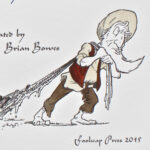Steps in the Right Direction
Summary: What follows here is my story of becoming involved with my immediate neighborhood to solve the issue of an unsightly asphalt ramp. The result is an example of how we can use the power of illustration better the world we all live in.
While it may be tempting to think that illustrators live out their lives sequestered away and isolated in their studios, I believe that we all know better. It takes a community network to support each of us, and ultimately to help make it possible for us to devote our time and energies towards living out our dreams. Occasionally, we are presented with an opportunity to give back in our own unique way.
Living In The City
Let’s start by taking a moment to talk about the neighborhood where I live as well as a little about where I come from. I hail from the small rural village of Hartville in Ohio; which is every bit as metropolitan as it sounds. So, coming from that rural background, when I eventually moved to San Francisco, I really thought it was going to be one huge anonymous concrete jungle. Perhaps I’ve watched one to many Film Noirs. However as time has gone on the opposite has been true, upon moving into our neighborhood I have found it to be a great community of diverse people. A place where neighbors check in with each other, and share a deep respect for one another. It’s a wonderful place with a dog friendly park at one end and cherry trees the bloom in the springtime lining the street, and most importantly it is full of genuinely nice folks.
The Lump Problem
Our neighborhood’s block is located next to the Harvey Milk Recreational Center here in San Francisco, and a few years ago the city began to renovate this community center.
In the long years prior to this, our lovely street had some great old stone stairs that lead up into the park. They were cobblestone steps that looked every day of a hundred years old (which may or may not be factually accurate, but that’s how they looked at any rate.) Somewhere in the renovation process the old steps were taken out, and in their place a large unsightly lump of asphalt was put in as a ramp. At that time our neighbor who lives closest to the steps talked directly with the contractor to insure that the steps would be replaced as they were. During the construction trucks and tractors drove in and out over the heinous lump at the end of our street, and people on bikes and skateboards would come ripping down the slope into our street.
Many of our neighbors have dogs, and we would see each other from time to time at the park where we would talk and shake our fists at the ugly lump of asphalt. As the days went by we all came to a loose collective agreement as to the degree of horribleness of the asphalt, some were concerned (and rightfully so,) about the potential of backing out of their driveway in to a biker or skateboarder as they came hauling ass down the street. To give a sense of the steepness of the grade, mothers pushing their children in strollers to the playground would have to hunker down behind them with their arms out like Superman just to get up the lump. We all agreed, the lump had to go and we wanted our steps back.
It wasn’t to be so. In the time during the construction the shady contractor that had taken out the steps (with out approval we were later to find out) had been kicked off the job, basically for being crap. What that meant for us was that there was now no chance of getting our steps back, and furthermore because the steps were gone and now had to be redone, they had to meet the current Americans with Disabilities Act (ADA) compliance standards. We were initially quite flummoxed as to how this lump of asphalt had met any compliance standards, and were later to find out that the crap contractor had called this area a “driveway” and was thus able to get around all the ADA complicity requirements.
The Meeting
Now we were stuck with a lump of asphalt where there once was a set of lovely steps. Our neighborhood really bonded together and we raised something of a ruckus with the District Representatives as well as with the Parks and Recreation Department. Eventually, there was a meeting scheduled between our neighborhood, and the other parties who were involved. We honed our concerns and discussed the problems at hand while we waited for the meeting to come around. As anyone who has ever had to get anything done through civic government will tell you, it is best to measure these moments in terms of geologic time.
Finally the evening of our meeting came. Knowing that for me it is easier to talk with pictures, I rushed home and quickly snapped a few pictures of the asphalt lump. Racing into my studio, I printed them out, then quickly traced over them drawing a solution which I felt was aesthetically pleasing as well as addressing the concerns of my neighbors.
The meeting went something like this: (to be read with the ‘announcer voice’) “On this side of the folding table, occupying about 20 folding chairs, The Neighbors! And, on that side of the table, wearing business suits, we have a handful of Public Officials!”
Let the games begin.
It started off with the public officials making a presentation and talking about their situation, and basically calling out the crap contractor for hosing everyone. Then it started, the complaints and concerns started flowing. If you’ve ever been in a meeting where this has happened, you will know that it’s a long way back to any kind of constructive conversation from that point. After a few minutes of this, I finally got up the nerve to say something. Holding up my drawing, I said something like,”Well I’ve got a solution here that I think meets all of our concerns.” As I began to point and explain my drawing someone said, “let me see that drawing,” and from there it made it around the room and up to the public officials. Everyone liked it, and just like that the meeting was over.
We all walked outside, and discussed how the drawing I’d made might be implemented. There were a few corrections that needed to be made, but overall the basic design was still there. While the original drawing are lost now, the drawings included here show the second drafts which include the changes we discussed after the meeting, for instance the required wheel chair ramp. We all left that meeting with a feeling of optimism and hope for beautifying our little corner of the world.
Waiting is the Hardest Part
After, a long, long, long time, we started to loose faith in the officials, who had assured us that the money was there for this project, and that they’d get on it right away. We began to suspect that they had vanished like so many farts in the wind. Many of those people did disappear into the labyrinthine corridors of city hall, and new people had taken their on their titles. The good will that we’d cultivated began to spoil.
Then, one magic day, a truck drove down our street and a team of guys began to block off the end of our street with barriers. Signs were erected directing foot traffic around, and orange barricades surrounded the asphalt lump. Finally it had come, the work had begun. Expectant and nervous, the neighborhood looked on as jack hammers pounded, and bobcats removed the old lump, and slowly replaced it with some nice granite steps and a smooth wheel chair ramp. Then, just as unceremoniously as it had begun, about a week after they had started the workers packed up all their gear and left. Behind them, they’d left a set of snazzy new steps which to me represent the fruits of cooperation, compromise, and a lot of patience.
Final Comments
I hope that some of you reading this will find opportunities to become involved within your respective communities. While the payback might not be a big fat check, I can say that for me personally, I feel that certain sense of pride knowing that I played a role in helping to create these steps. These steps represent a moment in time when a community was able to come together to surmount a common problem. During the process people were allowed to express themselves and everyone was heard in turn. When viewed in this way, it is a moment when things went well, and the result were simply good, nothing more, nothing less. In short, these steps have come represent; steps in the right direction.
As ever, I respond well to enthusiasm, and your feedback is welcome here.
Cheers,
Brian






Yay for community action! There’s definitely power in a group of good people getting together and affecting even a small corner of the world.
Mostly this post made me think of how powerful images can be in simmering things down. I don’t know how many meetings I’ve been in where people talk and talk and talk, and misunderstand each other, and it all looks like an inevitable slide into chaos. Meanwhile I or someone else is working frantically on an image or two, and then we pop them up on the screen or the whiteboard. Suddenly everyone refocuses and starts cooperating, because the simple image:
1. totally removes abstraction from the discussion
2. gives imagination a specific starting point
3. can be changed by anyone… don’t like a line I made? here’s the marker!
Great reminder of that, thank you.
Howdy Sean,
Thank you so much for taking the time to read through the story. Your comment really reminds me of a book I started reading awhile back entitled, “The Back of the Napkin” by Dan Roam. Basically his whole premise that ANY problem can be solved through the usage of pictures.
Thank you
[…] Read more about… Steps in the Right Direction […]
Bravo for taking on something that strengthened your neighborhood. It’s that “a picture is worth a thousand words” truth. Or in your case saved a thousand words. People love to look at pictures. I’m guessing a thousand word description would not have had the same impact to act. I’m glad you lived long enough to see that awesome result. What a great story!!
Donna